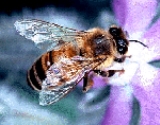
Characteristics of common wasps and bees
Encyclopedia
While easily confused at a distance or without close observation, there are many different characteristics of common large bee
s and wasp
s which can be used to identify them.
Bee
Bees are flying insects closely related to wasps and ants, and are known for their role in pollination and for producing honey and beeswax. Bees are a monophyletic lineage within the superfamily Apoidea, presently classified by the unranked taxon name Anthophila...
s and wasp
Wasp
The term wasp is typically defined as any insect of the order Hymenoptera and suborder Apocrita that is neither a bee nor an ant. Almost every pest insect species has at least one wasp species that preys upon it or parasitizes it, making wasps critically important in natural control of their...
s which can be used to identify them.
| Bee Bee Bees are flying insects closely related to wasps and ants, and are known for their role in pollination and for producing honey and beeswax. Bees are a monophyletic lineage within the superfamily Apoidea, presently classified by the unranked taxon name Anthophila... s |
Wasp Wasp The term wasp is typically defined as any insect of the order Hymenoptera and suborder Apocrita that is neither a bee nor an ant. Almost every pest insect species has at least one wasp species that preys upon it or parasitizes it, making wasps critically important in natural control of their... s (Family: Vespidae) |
|||||
|---|---|---|---|---|---|---|
| Western honey bee | Bumblebee Bumblebee A bumble bee is any member of the bee genus Bombus, in the family Apidae. There are over 250 known species, existing primarily in the Northern Hemisphere although they are common in New Zealand and in the Australian state of Tasmania.Bumble bees are social insects that are characterised by black... |
Yellow Jacket | Paper Wasp Paper wasp Paper wasps are -long wasps that gather fibers from dead wood and plant stems, which they mix with saliva, and use to construct water-resistant nests made of gray or brown papery material... |
Bald-faced hornet Bald-faced hornet Dolichovespula maculata is a North American insect commonly called the bald-faced hornet... |
Hornet Hornet Hornets are the largest eusocial wasps; some species can reach up to in length. The true hornets make up the genus Vespa and are distinguished from other vespines by the width of the vertex , which is proportionally larger in Vespa and by the anteriorly rounded gasters .- Life cycle :In... (European hornet European hornet The European hornet Vespa crabro, commonly known simply as the "hornet", is the largest European eusocial wasp. The queen measures 25 to 50 mm long; males and workers are smaller... ) |
|
 |
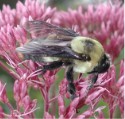 |
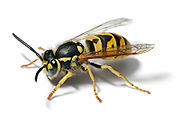 |
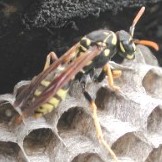 |
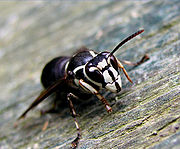 |
 |
|
| Colors | Amber to brown translucent alternating with black stripes. (video) | Yellow with black stripes, sometimes with red tail, to dark. (video) | Black and opaque bright yellow stripes. (video) | Dusty yellow to dark brown or black. (video) | Black and ivory white markings. (video) | Black and dark body with yellow. (video) |
| Coat | Furry (short hair). | Furry (long hair). | Little or no hair. | Some hair. | ||
| Size | 1.3 cm (0.511811023622047 in) | 2.5 cm (0.984251968503937 in) | 1.3 cm (0.511811023622047 in) | 1.9 to 2.5 cm (0.748031496062992 to 0.984251968503937 in) | up to 1.9 cm (0.748031496062992 in) | up to 3.5 cm (1.4 in) |
| Legs | Not generally visible while flying. | Two long legs are visible hanging down during flight. There are no pollen baskets. | ||||
| Behavior | Gentle. | Gentle. | Aggressive. | Gentle. | Aggressive. | Gentle. |
| Food | Nectar from flowers. | Other insects, overripe fruit, sugary drinks, human food / food waste, meat. | Other insects. | |||
| Sting | Kills bee., continues pumping (barbed) | Retracts; can repeat (smooth). | ||||
| Sting Pain Schmidt Sting Pain Index The Schmidt Sting Pain Index is a pain scale rating the relative pain caused by different Hymenopteran stings. It is mainly the work of Justin O. Schmidt, an entomologist at the Carl Hayden Bee Research Center in Arizona... |
2.x | 2.0 | 2.0 | 3.0 | 2.0 | 2.x |
| Lights | Not attracted to lights at night. | Attracted to lights at night. | ||||
| Lives in | Large colonies of flat wax-based honeycomb hanging vertically. | Small cavities in the soil. | Small umbrella-shaped papery combs hanging horizontally in protected spaces such as attics, eaves or soil cavities. | Large paper nest, upside down pear shaped, hanging from branches. / eaves | Very large paper nest in hollow trees, sheltered positions. | |

